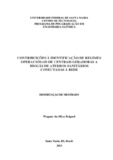| dc.creator | Brignol, Wagner da Silva | |
| dc.date.accessioned | 2017-06-06 | |
| dc.date.available | 2017-06-06 | |
| dc.date.issued | 2013-02-22 | |
| dc.identifier.citation | BRIGNOL, Wagner da Silva. Contributions to the identification of operating systems central generating for biogas of sanitary landfill connected to the network. 2013. 96 f. Dissertação (Mestrado em Engenharia Elétrica) - Universidade Federal de Santa Maria, Santa Maria, 2013. | por |
| dc.identifier.uri | http://repositorio.ufsm.br/handle/1/8518 | |
| dc.description.abstract | This paper aims to propose the development of strategies for setting the best times of the day when a distributed generation of electricity (GD), which uses the biogas as fuel chemical reactions in urban solid waste, deposited in landfills sanitary, can dispatch electricity as a distribution network in order to meet the quality indices of power (PQ) established in PRODIST / ANEEL (2010). For the development of this work was carried out to evaluate the electrical characteristics of a distribution network (feeder) belonging to the distribution system of the concession area of the State Company for Electric Power Distribution (CEEE-D), which serves a landfill located in the Greater Porto Alegre, which has energy potential for installation of GD. The methodology used to define the best operating systems was the methodology multicriterial Analytic Hierarchy Process - AHP, using the M-MACBETH software. In this methodology were considered quantitative and qualitative criteria. Quantitative criteria are represented by real data, which indicate directly the value of each technical feature in the process, and they suffer direct influence with the inclusion of DG in the distribution network. Qualitative criteria are those with imprecision in their values and / or difficulties in their quantification in the case of this study, Ancillary Services. The criteria used in this study were chosen and valued by agents Decision (AD) composed of Specialists electricity distributor and Specialists by GD, which together defined the needs and the weights of these criteria. The evaluation takes place in conjunction between the quantitative and qualitative criteria and the result is a classification (ranking) of times when it is most advantageous to insert the energy generated by the GD system. | eng |
| dc.format | application/pdf | por |
| dc.language | por | por |
| dc.publisher | Universidade Federal de Santa Maria | por |
| dc.rights | Acesso Aberto | por |
| dc.subject | Resíduos sólidos urbanos | por |
| dc.subject | Biogás | por |
| dc.subject | Geração distribuída | por |
| dc.subject | Método multicritério AHP | por |
| dc.subject | Urban solid waste | eng |
| dc.subject | Biogas | eng |
| dc.subject | Distributed generation | eng |
| dc.subject | Multicriteria AHP method | eng |
| dc.title | Contribuições à identificação de regimes operacionais de centrais geradoras a biogás de aterros sanitários conectadas à rede | por |
| dc.title.alternative | Contributions to the identification of operating systems central generating for biogas of sanitary landfill connected to the network | eng |
| dc.type | Dissertação | por |
| dc.description.resumo | Este trabalho tem por objetivo propor o desenvolvimento de estratégias de definição dos melhores períodos do dia em que uma geração distribuída de energia elétrica (GD), que utiliza como combustível o biogás proveniente de reações químicas de resíduos sólidos urbanos (RSU), depositados em Aterros Sanitários, possa despachar energia elétrica em uma rede de distribuição, de forma a atender os índices de qualidade de energia elétrica (QEE) estabelecidos no PRODIST/ANEEL (2010). Para o desenvolvimento deste trabalho foi realizada a avaliação das características elétricas de uma rede de distribuição (Alimentador), pertencente ao sistema de distribuição da área de concessão da Companhia Estadual de Distribuição de Energia Elétrica (CEEE-D), que atende um aterro sanitário localizado na região da Grande Porto Alegre, o qual possui potencial energético para instalação da GD. A metodologia utilizada para definir os melhores regimes operacionais foi a metodologia Multicriterial Analytic Hierarchy Process - AHP, através da utilização do software M-MACBETH. Nesta metodologia foram considerados critérios quantitativos e qualitativos. Os critérios quantitativos são representados por dados reais, que indicam diretamente o valor de cada característica técnica no processo, e estes, sofrem influência direta com a inclusão da GD na rede de distribuição. Os critérios qualitativos são aqueles que apresentam imprecisão em seus valores e/ou dificuldades em sua quantificação, no caso deste trabalho, Serviços Ancilares. Os critérios utilizados neste trabalho foram escolhidos e valorados por Agentes de Decisão (AD) compostos por Especialistas da Distribuidora e pelos Especialistas da GD, que em conjunto, definiram as necessidades e os pesos destes critérios. A avaliação se dá em conjunto com os critérios quantitativos e qualitativos e o resultado é uma classificação (ranking) dos horários em que é mais vantajosa a inserção da energia gerada pela GD no sistema. | por |
| dc.contributor.advisor1 | Canha, Luciane Neves | |
| dc.contributor.advisor1Lattes | http://lattes.cnpq.br/6991878627141193 | por |
| dc.contributor.referee1 | Farret, Felix Alberto | |
| dc.contributor.referee1Lattes | http://lattes.cnpq.br/5783619992936443 | por |
| dc.contributor.referee2 | Ramos, Diego Berlezi | |
| dc.contributor.referee2Lattes | http://lattes.cnpq.br/9143184033328069 | por |
| dc.creator.Lattes | http://lattes.cnpq.br/6355640086880364 | por |
| dc.publisher.country | BR | por |
| dc.publisher.department | Engenharia Elétrica | por |
| dc.publisher.initials | UFSM | por |
| dc.publisher.program | Programa de Pós-Graduação em Engenharia Elétrica | por |
| dc.subject.cnpq | CNPQ::ENGENHARIAS::ENGENHARIA ELETRICA | por |


